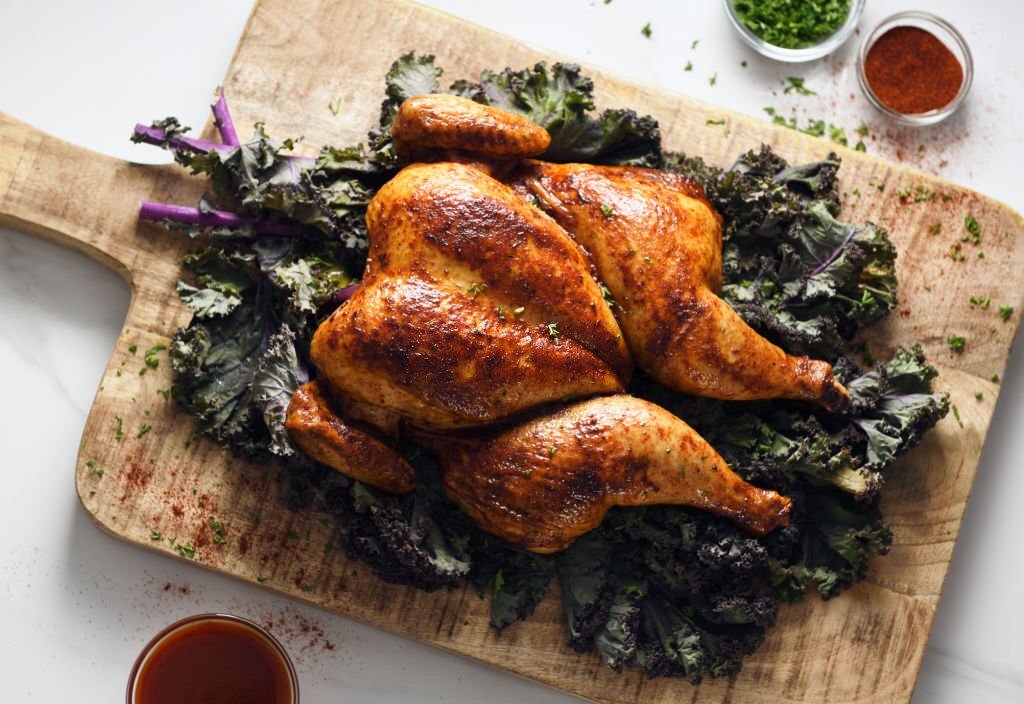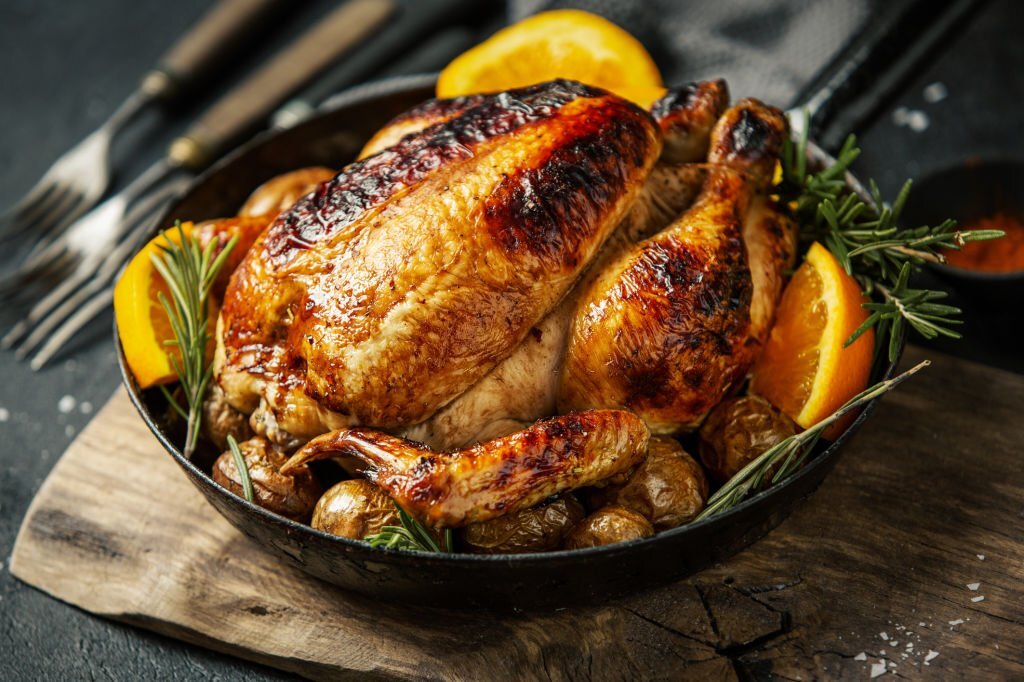How Long Is Rotisserie Chicken Good For?
- What Is A Rotisserie Chicken?
- How Long Is A Rotisserie Chicken Good For?
- Storage Tips for Extending Shelf Life
- What Are The Conditions That Cause Rotisserie Chicken To Spoil?
- Signs Of Spoiled Rotisserie Chicken
- Safety Considerations And Best Practices
- The Benefits Of Using A Rotisserie Chicken
- FAQs
- Conclusion
Rotisserie chicken has become a popular choice for many people seeking a convenient and delicious meal. It’s tender and flavorful meat, combined with the ease of availability at grocery stores and restaurants, has made it a go-to option for busy individuals and families. However, as with any perishable food item, it is crucial to understand how long rotisserie chicken stays good.
This knowledge not only ensures that you enjoy a safe and enjoyable meal but also helps minimize food waste. In this article, we will delve into the topic of how long is rotisserie chicken good for, storage tips to extend its freshness, signs of spoilage to watch out for, and essential safety considerations. By the end, you will be equipped with the necessary information to make informed decisions about the longevity and quality of rotisserie chicken.
What Is A Rotisserie Chicken?
A rotisserie chicken is a whole chicken that is cooked using the rotisserie cooking method. The chicken is typically skewered onto a long metal rod or spit and slowly rotated over a heat source, such as an open flame or an electric heating element. As the chicken rotates, the heat evenly cooks the meat, resulting in a juicy and flavorful bird with a crispy skin.
Rotisserie chicken is known for its convenience and versatility. It is commonly found in grocery stores, delis, and restaurants, where it is often pre-seasoned or marinated before being cooked on the rotisserie. This cooking method allows the chicken to retain its natural juices, making it moist and tender. It is a popular choice for those seeking a ready-to-eat meal or a quick solution for family dinners, picnics, or gatherings.
Rotisserie chicken’s popularity stems from its easy preparation, delicious taste, and versatility in various dishes. It’s a staple in households and a favorite among food enthusiasts seeking a hassle-free, satisfying meal option.
How Long Is A Rotisserie Chicken Good For?

The shelf life of a rotisserie chicken can vary depending on several factors, including how it was stored, the freshness at the time of purchase, and whether it has been opened or consumed partially. Generally, a properly stored and refrigerated rotisserie chicken can remain good for 3 to 4 days.
If you plan to consume the rotisserie chicken within a couple of days, it is best to keep it refrigerated in its original packaging or transfer it to an airtight container to maintain its freshness. However, if you don’t anticipate consuming it within that timeframe, it is advisable to freeze the chicken to extend its shelf life.
When stored in the freezer at or below 0°F (-18°C), a rotisserie chicken can last for up to 4 months while still maintaining its quality. Freezing helps slow down the deterioration process, but it’s important to note that the texture of the chicken may change slightly upon thawing. To thaw frozen rotisserie chicken, it is recommended to transfer it to the refrigerator and allow it to defrost slowly for best results.
Storage Tips for Extending Shelf Life
Proper storage is key to extending the shelf life of rotisserie chicken. Here are some helpful tips:
- Refrigerate promptly: If you’re not consuming the rotisserie chicken immediately, refrigerate it as soon as possible after purchase or consumption. The chicken should be refrigerated within two hours of being cooked to prevent bacterial growth.
- Use appropriate containers: Store the rotisserie chicken in its original packaging if it is still intact and secure. Alternatively, transfer it to airtight containers or wrap it tightly in plastic wrap or aluminum foil. This helps prevent moisture loss and cross-contamination with other foods.
- Maintain refrigerator temperature: Set your refrigerator temperature at or below 40°F (4°C) to ensure optimal storage conditions. A colder temperature helps slow down bacterial growth and keeps the chicken fresh for a longer time.
- Separate from other foods: To prevent cross-contamination, store the rotisserie chicken away from other foods, especially those that are raw or prone to spoiling quickly. Use separate shelves or storage areas to avoid any potential contamination.
- Consume or freeze within 3-4 days: Refrigerated rotisserie chicken should be consumed within 3-4 days of refrigeration to ensure its quality and safety. If you don’t plan to consume it within that timeframe, consider freezing it for later use.
- Freezing for extended storage: If you want to extend the shelf life further, wrap the rotisserie chicken tightly in freezer-safe packaging or place it in freezer bags. Label and date the package for easy identification. It can remain frozen for up to 4 months without significant loss of quality.
- Thawing frozen rotisserie chicken: When ready to use frozen rotisserie chicken, thaw it in the refrigerator overnight or use the defrost setting on your microwave. Avoid thawing at room temperature to prevent bacteria growth.
What Are The Conditions That Cause Rotisserie Chicken To Spoil?
Rotisserie chicken is a convenient and delicious food that can be enjoyed in many ways. However, it can also spoil quickly if not stored properly or consumed within a reasonable time. Some of the conditions that can cause rotisserie chicken to spoil are:
Temperature
Rotisserie chicken should be stored at safe temperatures to prevent bacterial growth and spoilage. The temperature danger zone, which ranges from 40°F (4°C) to 140°F (60°C), is where bacteria multiply rapidly. To maintain freshness, hot rotisserie chicken should be kept above 140°F (60°C) and cold rotisserie chicken below 40°F (4°C) .
Time
The longer rotisserie chicken is left at room temperature or in the danger zone, the more bacteria can grow, leading to spoilage. Rotisserie chicken should be refrigerated or frozen as soon as possible after purchase or cooking. Cooked rotisserie chicken can last up to 3-4 days in the refrigerator or up to 4 months in the freezer.
Contamination
Proper handling and hygiene practices are essential to prevent contamination and spoilage of rotisserie chicken. Contamination can occur from dirty hands, insects, mold spores, or food poisoning bacteria . Rotisserie chicken should be stored in an airtight container or wrapped tightly in plastic wrap or aluminum foil to avoid exposure to air and other contaminants . Rotisserie chicken should also be cooked to an internal temperature of 165°F (74°C) to kill any harmful bacteria .
Signs Of Spoiled Rotisserie Chicken
It’s important to be able to identify the signs of spoiled rotisserie chicken to ensure food safety. Here are some common indicators of spoilage to watch out for:
- Unusual odor: If the rotisserie chicken emits a strong, unpleasant odor, such as a sour or rotten smell, it is likely spoiled. Fresh chicken should have a neutral or slightly meaty scent.
- Slimy texture: If the surface of the chicken feels slimy or sticky to the touch, it indicates bacterial growth and spoilage. Fresh chicken should have a moist but not slimy texture.
- Abnormal discoloration: Discoloration can be a sign of spoilage. If you notice any green, gray, or yellow patches on the chicken’s skin or flesh, it is best to discard them. Fresh chicken should have a pinkish or off-white color.
- Mold growth: Mold is a visible sign of spoilage. If you see any mold spots or fuzzy growth on the rotisserie chicken, it should be discarded immediately.
- Changes in texture: If the chicken feels excessively dry, mushy, or has a tough and rubbery texture, it may have gone bad. Fresh rotisserie chicken should have a moist and tender texture.
- Off-flavors: If the taste of the chicken is off or unpleasant, it could indicate spoilage. Trust your taste buds and avoid consuming chicken that tastes strange or different from what you would expect.
Safety Considerations And Best Practices
When handling rotisserie chicken, it is important to prioritize safety considerations and follow best practices to prevent foodborne illnesses. Here are some key points to keep in mind:
- Hygiene: Practice proper hand hygiene by washing your hands thoroughly with soap and water before and after handling raw or cooked chicken. This helps prevent the spread of bacteria.
- Avoid cross-contamination: Prevent cross-contamination by using separate cutting boards, utensils, and plates for raw and cooked chicken. Clean and sanitize surfaces and equipment that come into contact with raw chicken to prevent the transfer of harmful bacteria.
- Cooking temperatures: Ensure that rotisserie chicken is cooked to a safe internal temperature. The chicken should reach at least 165°F (74°C) in all parts to kill any potential bacteria, including pathogens like Salmonella and Campylobacter.
- Reheating: When reheating rotisserie chicken, make sure it reaches a temperature of 165°F (74°C) to kill any bacteria that may have multiplied during storage. Use a food thermometer to check the internal temperature.
- Storage guidelines: Follow proper storage guidelines to minimize bacterial growth. Refrigerate rotisserie chicken promptly, discard any leftovers that have been left at room temperature for more than two hours, and adhere to recommended storage times.
- Use-by dates: Pay attention to use-by dates and consume rotisserie chicken before the expiration date indicated on the packaging to ensure its freshness and quality.
The Benefits Of Using A Rotisserie Chicken
The benefits of using a rotisserie chicken are many and varied. A rotisserie chicken is a whole chicken that has been cooked on a rotating spit over a heat source, usually a grill or an oven. This method of cooking results in a chicken that is juicy, tender, and flavorful, with a crispy skin that is seasoned with herbs and spices. Some of the benefits of using a rotisserie chicken are:
- It saves time and effort. You don’t have to spend hours preparing and cooking a raw chicken, or worry about undercooking or overcooking it. A rotisserie chicken is ready to eat in minutes, and you can use it for various dishes, such as salads, sandwiches, soups, casseroles, and more.
- It saves money. A rotisserie chicken is usually cheaper than buying a raw chicken of the same weight, and it can feed a family of four or more. You can also use the leftover bones and meat to make stock or broth, which can be used for other recipes or frozen for later use.
- It is healthy. A rotisserie chicken is low in fat and high in protein, as most of the fat drips off during the cooking process. You can also remove the skin if you want to reduce the calories and cholesterol. A rotisserie chicken provides essential nutrients, such as iron, zinc, selenium, and vitamin B12, which support the immune system, metabolism, and nervous system.
FAQs
How To Reheat A Rotisserie Chicken?
To reheat a rotisserie chicken, preheat the oven to 350°F (175°C), place the chicken in a baking dish, cover it with foil, and heat for about 20-30 minutes until warmed through. Alternatively, you can microwave individual portions on a microwave-safe plate, using short intervals and checking for doneness.
Does Rotisserie Chicken Have Bacteria?
Rotisserie chicken can potentially harbor bacteria, including common pathogens like Salmonella and Campylobacter, if not handled, stored, or cooked properly.
How Many Times Can You Reheat Rotisserie Chicken?
It is recommended to reheat rotisserie chicken only once to ensure food safety and maintain its quality. Multiple reheating cycles can increase the risk of bacterial growth and diminish the taste and texture of the chicken.
Can Rotisserie Chicken Make You Sick?
Consuming improperly stored or undercooked rotisserie chicken can potentially lead to foodborne illnesses, so proper storage, handling, and cooking practices are essential to minimize the risk of getting sick.
Conclusion
In conclusion, understanding how long rotisserie chicken remains good is crucial for ensuring food safety and minimizing waste. Refrigerated rotisserie chicken typically lasts for 3 to 4 days, while freezing can extend its shelf life up to 4 months. It’s important to be aware of signs of spoilage, follow proper storage and reheating practices, and prioritize food safety. By doing so, you can enjoy the convenience and deliciousness of rotisserie chicken while staying healthy.
Claire Lower
Claire is LiveandFeel Senior Food Editor. She has a BS in chemistry, a decade of food journalism experience, and a deep love for mayonnaise and MSG. As a Senior Food & Beverage Writer for liveandfeel, where I generate exciting content covering topics such as culinary trends, recipes, and perhaps even health and wellness aspects related to food. that not only informs but also captivates a sizable audience.







